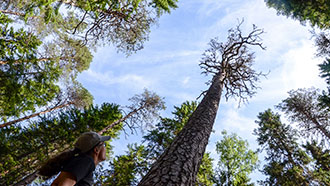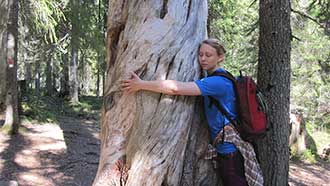Natural Features of Pyhä-Häkki National Park
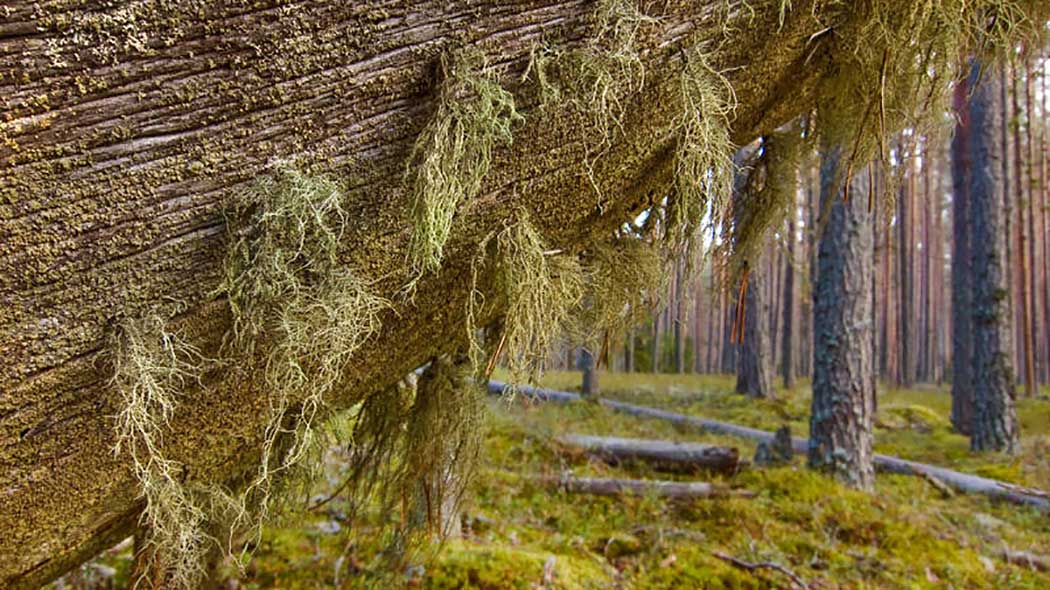
Old-growth Forests and Majestic Pine trees

The man has hardly ever disturbed the ecosystems in Pyhä-Häkki. The forest is known as the most remarkable old-growth forest of the Southern Finland. Most of the forest is naturally developed, only affected by forest fires and storms. The average age of pine forests with their ancient living Pine (Pinus sylvestris) trees, and dead standing trees is often up to 300 years. The oldest trees are from the end of 1500s.
Getting older, the pines bark turns into shield bark, resembling the pattern on the back of a turtle. The shield bark means that the tree is at least 200 years old. In Pyhä-Häkki, these old pine trees are proud symbols of the ancient forest. They keep standing - dead or alive - for 500 years and survive the forest fires because of their thick bark. Sometimes the fire leaves a scar on the trees bark, which can be still seen by the next generations.

The history of the forest fires in Pyhä-Häkki is known since 1508. Altogether 44 forest fires have separately and together affected the success of the different species of trees in the National Park area. Most of the fire scars which can be seen on the pine trees now were made by the forest fires in the 1700s, when some the forest burned about every 9 years. During a great fire in the long, hot summer 1858, most of the park was on fire. Also the 1855 forest fire had a remarkable effect on the landscape, when the whole treestand on one about 1-km-long ridge was burned down at once. Nowadays, at that place grows a beautiful pine forest of even age.
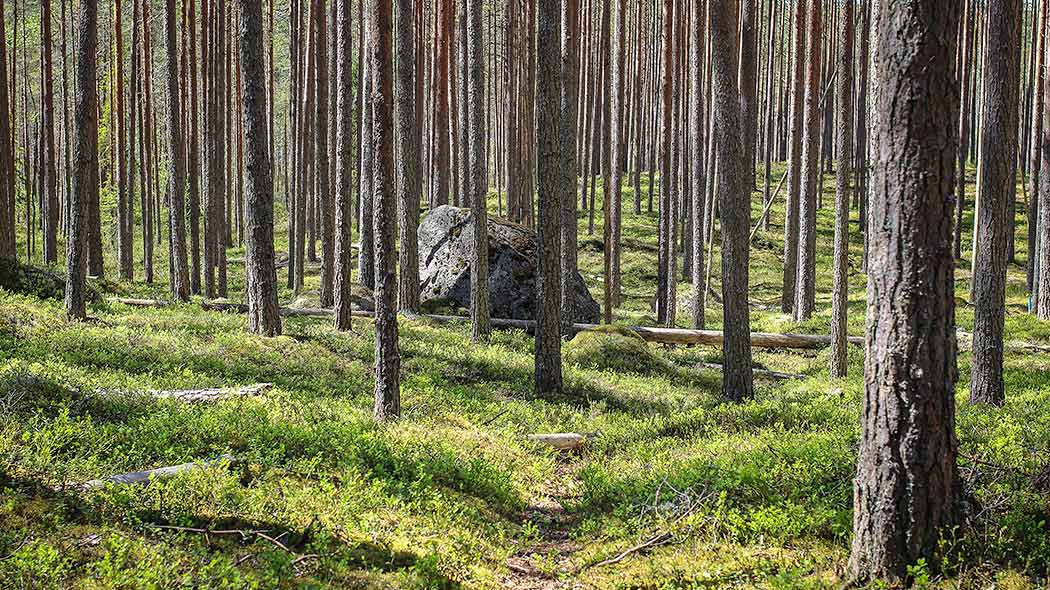
In the end of 1800s, when slash-and-burn agriculture was no longer practised and fire-guarding became more common, the forest fires became rare. The last forest fire was in 1921, when about 0,1 sq.km. of forest burned.
A Mosaic of Forests and Mires
Half of the national park area is forests and the other half is mires. Kotaneva and Riihineva are among the most impressive mires, and they are also accessible via duckboards. You can often see lizards and dragonflies resting on the duckboards. In the early summer, listen for the song of a Wood Sandpiper (Tringa glareola) when it’s perched on top of a twisted pine tree. The mires in the park are very diverse:
- The most common type of mire in the National Park is the Dwarf-shrub pine bog, growing pines and the Marsh tea (Ledum palustre).
- Some of the mires are Low-sedge bogs, dominated by the Sheathed Cottonsedge (Eriophorum vaginatum) and the Sphagnum moss, which is typical for barren watershed regions.
- There are also luxuriant types of mire, such as herb-rich hardwood-spruce swamps, dominated by the spruce.
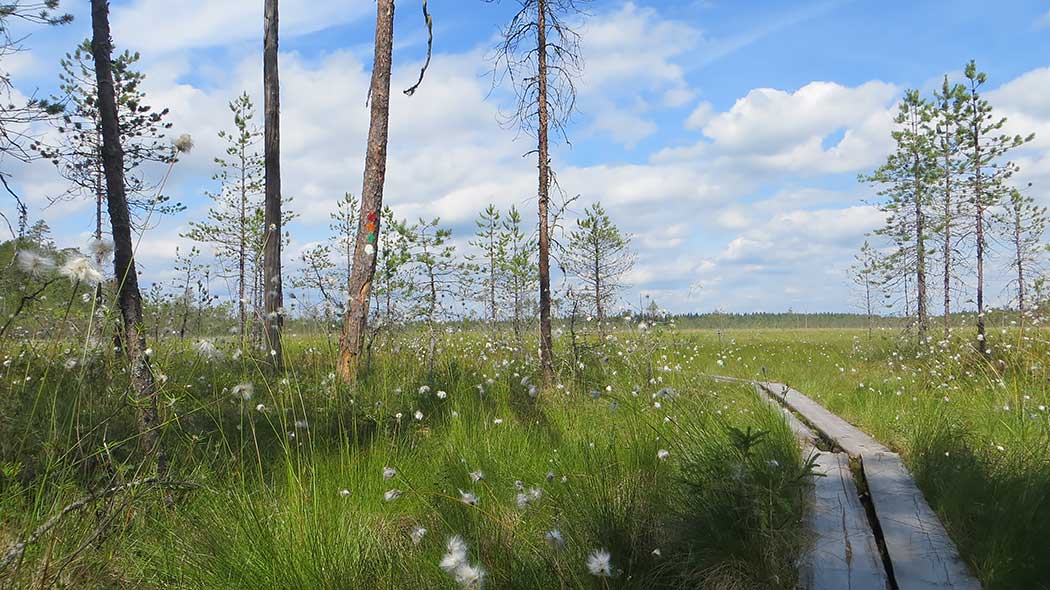
Pyhä-Häkki is Home to Birds that Prefer the Ancient forest
Hole-nesting Birds
Dead standing trees offer fantastic nesting and feeding place for many bird species. The Ural Owl (Strix uralensis) often nests in broken dead standing trees. You can see and hear the Black Woodpecker (Dryocopus martius), which is the emblem of the park, the Great Spotted Woodpecker (Dendrocopos major) and the Three-toed Woodpecker (Picoides tridactylus) making holes in the trees. The Tengmalm’s Owl (Aegolius funereus) often nests in Black Woodpecker holes while the Pygmy Owl (Glaucidium passerinum) prefers holes made by the Three-toed Woodpecker. All the Paridae species can be seen and heard here year-round. The Great Tit (Parus major), the Blue Tit (Parus caeroleus), the Willow Tit (Parus montanus) and the Crested Tit (Parus cristatus) all thrive in the forests of Pyhä-Häkki National Park.

Beautiful Song
The Common Treecreeper (Certhia familiaris ) is a typical inhabitant of the old forests and the chipper song of the Goldcrest (Regulus regulus)can sometimes be heard from dense spruce forests. The most vocal of the migrating birds in the area are the Pied Flycatcher (Ficedula hypoleuca) and the Chaffinch (Fringilla coelebs). A sharp-eared bird enthusiast can also recognise the song of the Greenish Warbler (Phylloscopus trochiloides).
A very lucky visitor may be rewarded by the clear noted song of one of the rare Red-flanked Bluetails (Tarsiger cyanurus), which have visited the park on several occasions. The Tree Pipit (Anthus trivialis) visits each summer migrating all the way from Africa. It is not a well-known specie as it is quite plain looking though it does sing strongly during flight.
Inhabitants of the Mires and Sandy Heathland Forests
Open bogs attract species such as the Crane (Grus grus), the Wood Sandpiper (Tringa glareola) and the Greenshank (Tringa nebularia) to nest. Forest tetraonids thrive in the vicinity of sandy heathland forests. The Western Capercaillie (Tetrao urogallus), the Black Grouse (Tetrao tetrix), the Hazel Grouse (Bonasa bonasia)and even the Red Grouse (Lagopus lagopus) may cross you path.
Many Busy Feet
The spiders with their eight legs, mice and voles with four, and birds and men with two, in the numbers of the individuals they cannot outdo the six-legged insects. In Pyhä-Häkki, like in many other places, the six-legged Red ant (Formica rufa) is the greatest species in number. With however many legs, all the creatures can walk around in the National Park in peace.

Moose and Bears Stay Away
Four-legged animals are a distinct minority in Pyhä-Häkki National Park in terms of population size. Now and then a Moose may wander to the edge of the mires, but will soon realise there is no food to be found. A moose eats new fresh leaves which grow on the very ends of branches of deciduous trees; these are not found in the area's old-growth forests. For this very same reason Bears the kings of the forest stay away from the national park. They follow the moose's' tracks and quickly catch on that their prey is systematically avoiding the national park and is instead heading for newer forest land.
Numerous Little Critters
The Common Lizard is a little critter which visitors see each summer lounging on the trail's duckboards. The Common Toad (Bufo bufo) can be found waddling over the trail in the shade of spruce trees and sometimes a legless traveller in the form of the European Viper (Vipera berus) may cross your path.
Then there are the inhabitants of the moss beds which are rarely seen but are just as important as any other animal. The Bank Vole (Clethrionymus glareolus) and the Water Vole (Arvicola terrestris) are a significant part of nature's cycle and the food chain. The most beautiful inhabitant of the moss bed is the Wood Lemming (Myopus schisticolor) which can be distinguished from the area's mice and voles by its stubby tail and the brown spots on its back.
Wintry Paw Prints
Winter's snow banks reveal the existence of other four-legged inhabitants. The bouncing tracks of the Squirrel (Sciurus vulgaris) run across the trail here and there. The infamous Pine Marten's (Martes martes) has a very distinct set of prints that often follow squirrel tracks.
The Stoat's with his black tipped tail is rarely seen, but his tracks are unmistakable. The European Otter's (Lutra lutra) paw prints and tail tracks are the easiest to spot in the snow. Also the fox's (Vulpes vulpes) tiny prints crisscross over mires and on top of ridges.
A Treasure-trove for Bracket Fungi
The polyporous fungi family are a varied group of fungi, which grow on wood and forest litter. They cause wood to decay and differ from other mushrooms appearance-wise in that they have a very sturdy fruit body, the under side of which is covered by a dense network of gills. The most common polyporous fungi are Phellinus igniarius, which grows on leafy trees and Fomes fomentarius, which has been used since prehistoric times as an aid in lighting fires.


The polyporous fungi found in Pyhä-Häkki mean that this old-growth forest is now classified as a unique forest area and extremely valuable, which is the highest possible classification. Over 70 species of polyporous fungi have been found in the National Park. This amounts to one-third of what is found in the entire country. Although some of these species grow on the under-side of fallen trees under layers of moss and are hidden from us, there are others that grow in clear sight on tree trunks. An Oligoporus lateritius with a rust brown tinted root grows on the trunk of a pine which has died standing and then fallen. An Antrodiella citrinella shines a bright yellow on the trunk of a spruce and the Leptoporus mollis can be recognised by its light pink colour. Those with a keen sense of smell can find the Haploporus odorus by following the wonderful fragrance it spreads.
Many polyporous fungi in Pyhä-Häkki National Park brighten up the autumn forest with their colours and bring a new perspective for attentive nature lovers on their forest trips.
Pyhä-Häkki National Park
- Established 1956
- Area 13 km²

The Emblem of Pyhä-Häkki National Park is Black Woodpecker
Publications of Pyhä-Häkki National Park
Publications of Pyhä-Häkki National Park (julkaisut.metsa.fi)

